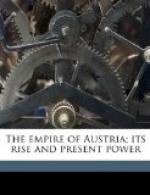The Ottoman power had now passed its culminating point, and was evidently on the wane. The Russian empire was beginning to arrest the attention of Europe, and was ambitious of making its voice heard in the diplomacy of the European monarchies. Being destitute of any sea coast, it was excluded from all commercial intercourse with foreign nations, and in its cold, northern realm, “leaning,” as Napoleon once said, “against the North Pole,” seemed to be shut up to barbarism. It had been a leading object of the ambition of Peter the Great to secure a maritime port for his kingdom. He at first attempted a naval depot on his extreme southern border, at the mouth of the Don, on the sea of Azof. This would open to him the commerce of the Mediterranean through the Azof, the Euxine and the Marmora. But the assailing Turks drove him from these shores, and he was compelled to surrender the fortresses he had commenced to their arms. He then turned to his western frontier, and, with an incredible expenditure of money and sacrifice of life, reared upon the marshes of the Baltic the imperial city of St. Petersburg. Peter I. died in 1725, leaving the crown to his wife Catharine. She, however, survived him but two years, when she died, in 1727, leaving two daughters. The crown then passed to the grandson of Peter I., a boy of thirteen. In three years he died of the small-pox. Anna, the daughter of the oldest brother of Peter I., now ascended the throne, and reigned, through her favorites, with relentless rigor.
It was one of the first objects of Anna’s ambition to secure a harbor for maritime commerce in the more sunny climes of southern Europe. St. Petersburg, far away upon the frozen shores of the Baltic, where the harbor was shut up with ice for five months in the year, presented but a cheerless prospect for the formation of a merchant marine. She accordingly revived the original project of Peter the Great, and waged war with the Turks to recover the lost province on the shores of the Euxine. Russia had been mainly instrumental in placing Augustus II. on the throne of Poland; Anna was consequently sure of his sympathy and cooeperation. She also sent to Austria to secure the alliance of the emperor. Charles VI., though his army was in a state of decay and his treasury empty, eagerly embarked in the enterprise. He was in a continued state of apprehension from the threatened invasion of the Turks. He hoped also, aided by the powerful arm of Russia, to be able to gain territories in the east which would afford some compensation for his enormous losses in the south and in the west.
While negotiations were pending, the Russian armies were already on the march. They took Azof after a siege of but a fortnight, and then overran and took possession of the whole Crimea, driving the Turks before them. Charles VI. was a very scrupulous Roman Catholic, and was animated to the strife by the declaration of his confessor that it was his duty, as a Christian prince, to aid in extirpating the enemies of the Church of Christ. The Turks were greatly alarmed by these successes of the Russians, and by the formidable preparations of the other powers allied against them.




